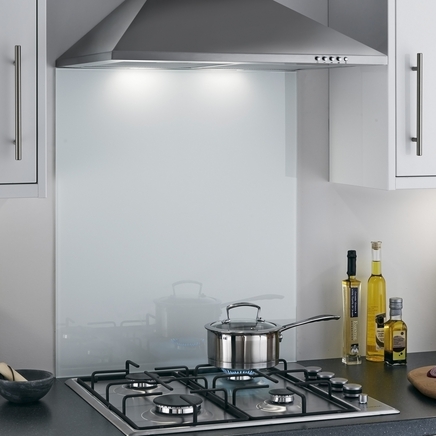Splashback
Contents |
[edit] Introduction
A splashback is a panel of material is used in spaces such as kitchens and bathrooms to protect walls and other surfaces from splashes. In kitchens, they are often placed behind the hob, protecting the wall from splashes caused by cooking as well as from heat damage. In bathrooms, they are often placed behind sinks and around bathtubs to prevent mould and mildew developing as a result of damp from spilt, sprayed or splashed water.
Splashbacks can be creatively designed to enhance or complement the room interior and can be made from a variety of materials.
[edit] Materials
[edit] Stainless steel
This is a sheet of flat steel fixed directly to the wall using glue or screws. This option is relatively affordable and easy-to-clean, while being heat-resistant and durable, although it will develop minor scratches over time.
[edit] Porcelain and ceramic tiles
Tiles are a popular option for splashbacks as they are scratch-, heat-, and water-resistant, and can be easier to clean than some other materials. They also have the advantages of being relatively affordable and easily installed, with an abundance of choice which encourages creativity. However, if a tile becomes chipped or damaged it will need to be removed and replaced, and the type and colour of grout to be used should be carefully considered. Grout will eventually need to be replaced to ensure continued moisture resistance and to recreate the original colour.
[edit] Glass
Glass is commonly used to add colour and a sleek aesthetic, and can be fitted in a large, seamless panel. Glass splashbacks are fixed to the wall using silicone or screws, and cut-outs can be included to accommodate fittings such as light switches and electric sockets. Tempered glass is stronger and more durable than ordinary glass and offers more scratch-resistance.
Mirrored glass can be chosen for a more look. Panels of up to 3 m in length are available, which reduces the need for joins. A drawback of mirrored glass is that is cannot be used behind a gas hob as cracks may form over time as a result of continuous expansion and contraction.
[edit] Engineered stone
This is typically manufactured from crushed quartz and resin, and is very tough and high-performing. Engineered stone will not stain, is easily cleaned and can be made in a wide range of colours. Like glass, it can be supplied in large panels, reducing the need for joins. However, this is a more expensive material to use and very often requires specialists to install it.
[edit] Granite
Granite is commonly used in more traditional settings, and every piece of stone will look different in some way. Granite is easy-to-clean and very durable, although it is an expensive option and requires sealing to prevent staining as it is porous.
[edit] Polished plaster
Polished plaster is highly versatile in terms of aesthetics, as it can be specified in any colour or texture. It requires very little maintenance once it’s been installed, although it may be prone to chipping which cannot be seamlessly repaired. As a precautionary measure, it is often recommended that small skirting is provided around the worktop edge to protect against damage.
[edit] Composites
Also known as solid surface materials, composites are typically made from a blend of one-third resin and two-thirds natural mineral. They are highly flexible and can be used to provide streamlined curves that require no joints between worktop and splashback. However, some varieties are prone to scratching and lack heat-resistance.
[edit] Laminate
Laminate is a more affordable alternative, and is hard-wearing and easy-to-clean. It should not be used behind a gas hob because of its flammability and needs to be carefully installed to prevent water ingress at joints.
[edit] Marble
While providing a luxurious aesthetic to a room, with lots of variety, marble is porous and so must be sealed and resealed to prevent staining. It also lacks scratch-resistance.
[edit] Related articles on Designing Buildings Wiki
Featured articles and news
RTPI leader to become new CIOB Chief Executive Officer
Dr Victoria Hills MRTPI, FICE to take over after Caroline Gumble’s departure.
Social and affordable housing, a long term plan for delivery
The “Delivering a Decade of Renewal for Social and Affordable Housing” strategy sets out future path.
A change to adoptive architecture
Effects of global weather warming on architectural detailing, material choice and human interaction.
The proposed publicly owned and backed subsidiary of Homes England, to facilitate new homes.
How big is the problem and what can we do to mitigate the effects?
Overheating guidance and tools for building designers
A number of cool guides to help with the heat.
The UK's Modern Industrial Strategy: A 10 year plan
Previous consultation criticism, current key elements and general support with some persisting reservations.
Building Safety Regulator reforms
New roles, new staff and a new fast track service pave the way for a single construction regulator.
Architectural Technologist CPDs and Communications
CIAT CPD… and how you can do it!
Cooling centres and cool spaces
Managing extreme heat in cities by directing the public to places for heat stress relief and water sources.
Winter gardens: A brief history and warm variations
Extending the season with glass in different forms and terms.
Restoring Great Yarmouth's Winter Gardens
Transforming one of the least sustainable constructions imaginable.
Construction Skills Mission Board launch sector drive
Newly formed government and industry collaboration set strategy for recruiting an additional 100,000 construction workers a year.
New Architects Code comes into effect in September 2025
ARB Architects Code of Conduct and Practice available with ongoing consultation regarding guidance.
Welsh Skills Body (Medr) launches ambitious plan
The new skills body brings together funding and regulation of tertiary education and research for the devolved nation.
Paul Gandy FCIOB announced as next CIOB President
Former Tilbury Douglas CEO takes helm.
UK Infrastructure: A 10 Year Strategy. In brief with reactions
With the National Infrastructure and Service Transformation Authority (NISTA).























